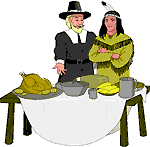"I" Still Isn't for IndianA look at recent publishing about Native Americans[T]he bulk of publishing about Native Americans since 2000 is disappointing. Other Thanksgiving books on the market portray the entrenched, traditional vision of the dominant culture. Robert Merrill Bartlett's classic The Story of Thanksgiving has been revised (HarperCollins, 2001), yet still shows readers a harmonious and full-blown friendship between the Wampanoag and Pilgrims, which, according to Grace and Bruchac, was more likely a wary truce. The Hollywood-happy vision is also apparent in many picture books. Laurie Halse Anderson's well-received Thank You, Sarah: The Woman Who Saved Thanksgiving (S & S, 2002) falters on the first page as Matt Faulkner's appealing cartoon illustrations show a line of smiling, waving Wampanoag women, children, and men, standing at the gates of the Plimoth colony and holding out a roasted turkey. Actually, Massasoit arrived that day with 90 men (having heard gunfire), and though many Americans are fixated on the turkey, it's clear that turkey was not the centerpiece of the "first Thanksgiving." Nearly every recent book about Thanksgiving reveals these same types of inaccuracies that we've been seeing for years.
Most of the nonfiction published about Native Americans is designed to help with "the tribe report." Raymond Bial's "Lifeways" series (Benchmark) has been acclaimed for its use of color photographs of contemporary people and reenactments. Yet, behind its fresh look, the series provides much of the same condescending, trivializing language and non-Native perspective as in less-attractive fare. The books are written almost entirely in the past tense, suggesting that these people and their ways of life are gone, and elements of Native cultures are depicted in opposition to European ones, suggesting that they are at odds.Comment: For more on the subject, see
The Best Indian Books.



No comments:
Post a Comment